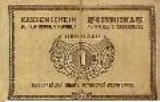
Estonian mark
Encyclopedia
The mark was the currency
of Estonia
between 1918 and 1928. It was initially equivalent to the German Papiermark
, which had been circulating alongside the Russian/Soviet ruble
since the German occupation. It was divided into 100 penni (in Nominative case: penn). It was replaced in 1928 by the Estonian kroon
at a rate of 1 kroon = 100 marka.
Currency
In economics, currency refers to a generally accepted medium of exchange. These are usually the coins and banknotes of a particular government, which comprise the physical aspects of a nation's money supply...
of Estonia
Estonia
Estonia , officially the Republic of Estonia , is a state in the Baltic region of Northern Europe. It is bordered to the north by the Gulf of Finland, to the west by the Baltic Sea, to the south by Latvia , and to the east by Lake Peipsi and the Russian Federation . Across the Baltic Sea lies...
between 1918 and 1928. It was initially equivalent to the German Papiermark
German papiermark
The name Papiermark is applied to the German currency from the 4th August 1914 when the link between the Mark and gold was abandoned, due to the outbreak of World War I...
, which had been circulating alongside the Russian/Soviet ruble
Russian ruble
The ruble or rouble is the currency of the Russian Federation and the two partially recognized republics of Abkhazia and South Ossetia. Formerly, the ruble was also the currency of the Russian Empire and the Soviet Union prior to their breakups. Belarus and Transnistria also use currencies with...
since the German occupation. It was divided into 100 penni (in Nominative case: penn). It was replaced in 1928 by the Estonian kroon
Estonian kroon
In 1992, coins were introduced in denominations of 5, 10, 20 & 50 senti, as well as 1 kroon. The 1 kroon was struck in cupronickel, the others in aluminum-bronze. However, in 1997, nickel-plated steel 20 senti were introduced, followed by aluminum-bronze 1 kroon in 1998. 5 senti coins were not...
at a rate of 1 kroon = 100 marka.

